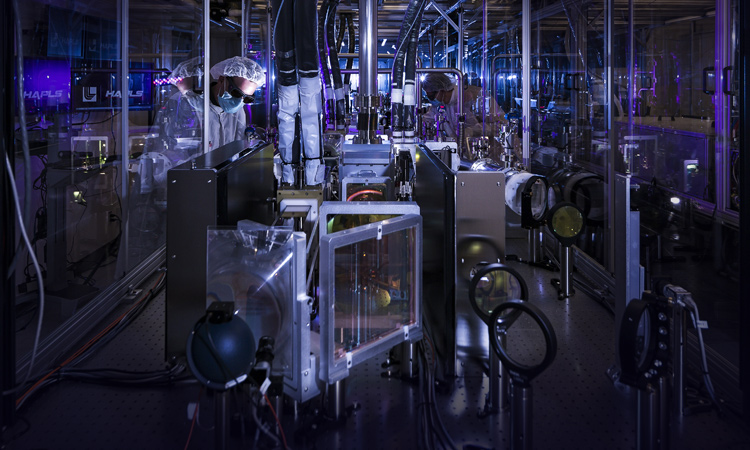 The High-repetition-rate Advanced Petawatt Laser System (HAPLS) has been built by Lawrence Livermore National Laboratory for the Extreme Light Infrastructure facility in the Czech Republic. [Courtesy of LLNL]
The High-repetition-rate Advanced Petawatt Laser System (HAPLS) has been built by Lawrence Livermore National Laboratory for the Extreme Light Infrastructure facility in the Czech Republic. [Courtesy of LLNL]
On 23 May 1996, scientists at the Lawrence Livermore National Laboratory (LLNL), USA, generated the first laser pulse exceeding 1 petawatt (PW; 1015 W) of peak power. That achievement—on the Nova Petawatt laser, an upgrade to the Nova fusion laser facility—signaled the birth of the field of high-intensity lasers, which have dramatically advanced the understanding of laser–matter interactions and of the fundamental nature of energy and matter over the ensuing 20 years.
The ability to generate peak laser powers greater than 1 PW came out of the invention of chirped-pulse amplification (CPA) at the University of Rochester. CPA enables the amplification of a broad-bandwidth pulse to tens or hundreds of joules at intensities below the damage limits of laser gain materials, and the pulse’s subsequent temporal recompression, by a factor of 10,000, to tens to hundreds of femtoseconds.
When tightly focused, PW-peak-power lasers can generate intensities of greater than 1021 W/cm2 and electromagnetic fields more than 100 times stronger than the field that binds electrons to atomic nuclei. This opens a range of interesting and potentially useful laser–matter interactions. Since the Nova Petawatt, numerous PW-class lasers have been built to investigate these effects, many of them leveraging the development of titanium-doped sapphire (Ti:sapphire) as a laser gain medium with sufficient gain bandwidth to support pulses as short as 10 fs.
However, these lasers still have one weakness: a very low pulse repetition rate. Many of them fire only once every few minutes, and even the advanced PW laser at the Lawrence Berkeley National Laboratory’s Berkeley Lab Laser Accelerator facility fires only once per second. A new generation of high-repetition-rate lasers, however—developed by LLNL for the emerging European Extreme Light Infrastructure (ELI)—is poised to increase the repetition rate of PW-peak-power laser pulses by an order of magnitude. In this article, we look at these emerging lasers, and the kind of science they make possible.
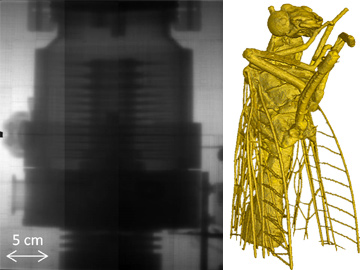 Laser-driven X-rays can aid industrial applications, such as enabling a radiograph of a turbomolecular vacuum pump (left), and basic science, such as imaging a fly with phase-contrast X-ray tomography (right). [C.M. Brenner et al., Plasma Phys. Contr. Fus. 58, 014039 (2015)/J. Wenz et al., Nat. Commun. 6, 7568 (2015).]
Laser-driven X-rays can aid industrial applications, such as enabling a radiograph of a turbomolecular vacuum pump (left), and basic science, such as imaging a fly with phase-contrast X-ray tomography (right). [C.M. Brenner et al., Plasma Phys. Contr. Fus. 58, 014039 (2015)/J. Wenz et al., Nat. Commun. 6, 7568 (2015).]
Secondary sources, primary results
The ability of PW-class lasers to contribute new science relates to their ability to create so-called secondary-source radiation. When focused, high-intensity lasers can rip electrons off a target—such as a gas jet, stream of liquid droplets, or a thin metallic or plastic wires and foils—and create a plasma. That plasma, in turn, creates secondary radiation or particle beams that can be deployed in multiple applications.
Using gas targets, for example, PW-peak-power laser pulses rip electrons off their parent atoms; the electrons, accelerated in the laser-induced electric fields, produce X-rays at a range of energies, from EUV radiation (which can be used for photolithography) up to the hard-X-ray regime. The same lasers can also be deployed to create a tabletop electron accelerator, creating very-high-energy electron beams. Combining electron acceleration with other lasers can produce narrow-bandwidth X-rays or gamma rays, used for non-destructive imaging or evaluation of materials, dense metals and structures, and more. Other experimental arrangements use protons or neutrons, laser-accelerated from solid targets, in applications like cancer therapy or medical imaging.
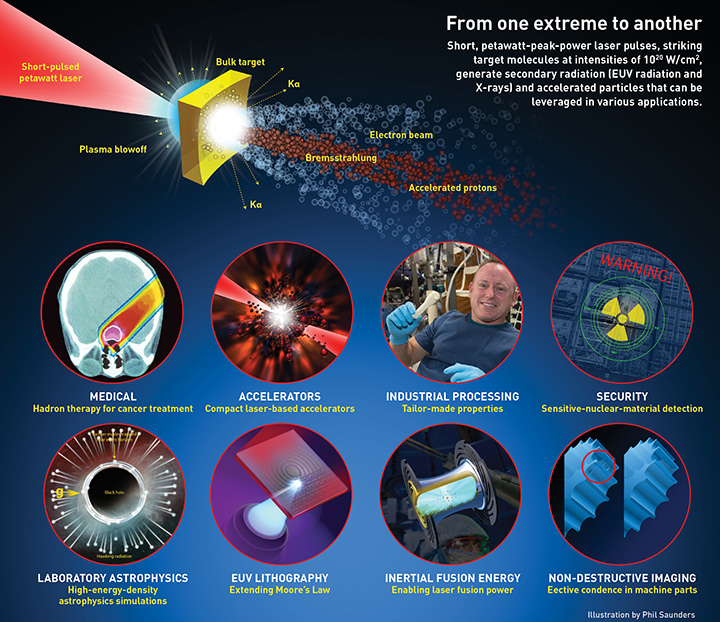
Enter ELI–Beamlines
These and other exciting, promising applications will all benefit from developments in PW laser technology—but many will require further development before they are ready to be used. That development is one of the primary motivations behind the creation of the ELI—a €850 million (US$1 billion) effort within the European Union to create a multisite, high-intensity laser science facility.
The three ELI sites will house some of the newest advances in extreme laser technology. Each facility has a different but complimentary focus, with a common thread of generating and using extreme light for discovery science. The ELI–Beamlines facility, located in Dolní Břežany, near Prague, Czech Republic, will have a particular focus on the development and use of ultrashort pulses of high-energy particles and radiation—the secondary sources described above, which stem from the relativistic interaction of laser light and matter. The other two sites—the ELI Attosecond Light Pulse Source (ELI–ALPS), in Szeged, Hungary, and ELI Nuclear Physics (ELI–NP), in Măgurele, Romania—will emphasize, respectively, new science enabled by extremely short light pulses, and new applications of laser-based nuclear physics in areas such as waste management, materials science, and life science.
In the remainder of this article, we focus on the lasers being developed for ELI–Beamlines, expected to be ready as a scientific user facility for the international community in 2018. At ELI–Beamlines, the ability of new lasers to produce extreme intensities on targets—in multiple pulses per second—should drive forward new discoveries in high-intensity laser science and transform laser-driven particle and radiation sources from scientific curiosities into viable tools. The facility will include six different “experimental halls,” each dedicated to a different application or research field—materials and biomedical applications, X-ray sources, plasma and high-field physics, ion acceleration and electron and photon sources.
The experimental halls will receive light supplied from four lasers:
-
The L1 beamline, developed in-house by the ELI–Beamlines, will generate 100-mJ pulses of less than 20-fs duration and at repetition rates of 1 kHz.
- The L2 beamline will aim at 15-fs, 1-PW pulses with a 10-Hz repetition rate, using laser diode pumping and nonlinear parametric amplification. It is at present a development project, and will be delivered after 2020.
-
The L3 beamline, called the High-Repetition-Rate Advanced Petawatt Laser System (HAPLS), was developed and built by LLNL and delivered to ELI –Beamlines in June 2017. Expected to become a major laser resource of the facility, L3 HAPLS is designed to deliver PW pulses with durations of less than 30 fs, at a 10-Hz repetition rate.
-
The L4 beamline, currently being built, is designed to produce peak power on the order of 10 PW, but with a longer pulse width (130 fs) and a much lower repetition rate (1 shot per minute) than L3 HAPLS.
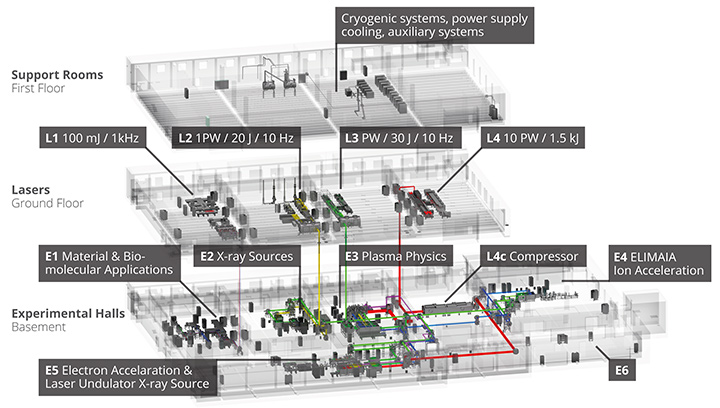 The ELI–Beamlines setup: The ELI–Beamlines facility shunts output from four laser beamlines on the ground floor to six experimental halls in the basement. [Courtesy of ELI–Beamlines]
The ELI–Beamlines setup: The ELI–Beamlines facility shunts output from four laser beamlines on the ground floor to six experimental halls in the basement. [Courtesy of ELI–Beamlines]
L3 HAPLS: The workhorse
Of the four primary lasers at ELI–Beamlines, the L3 HAPLS could emerge the workhorse for fundamental research and development of applications across the six experimental halls. A key to its usefulness lies in its 10-Hz repetition rate—which, in turn, stems from its use of laser diode pumping technology.
Of the four primary lasers at ELI–Beamlines, the L3 HAPLS could emerge the workhorse for fundamental research and development of applications.
Producing pulses as short as tens of femtoseconds requires significant spectral bandwidth. Ti:sapphire gain material can provide that bandwidth—but it has a relatively short excited-state lifetime. This means that the gain medium must be completely energized in only a few microseconds. For that reason, most PW-class lasers are pumped with an intermediate Nd-doped pump laser system, which itself is energized by the decades-old flashlamp-based optical pumping technology. Flashlamps are a mature and relatively low-cost technology, but they’re extremely inefficient for pumping lasers. That’s because their broad emission spectrum is mismatched with the lasers absorption features; most of the flashlamp’s energy thus is deposited into the laser system as heat, a characteristic that limits the repetition rate of joule-class flashlamp-pumped lasers to at most a few pulses per second.
In contrast, the laser diode pumping technology of the L3 HAPLS is much more electrically and optically efficient, because the spectral overlap of the laser diode emission can be closely tuned to the absorption feature of the gain medium. As a result, the laser can run at pulse repetition rates of 10 Hz or higher. Further, the diodes have a useful lifetime of approximately 200 times the number of laser shots as the flashlamps used in other high-energy pump lasers.
These advantages make diode-pumping much more attractive than the more traditional flashlamp option when the PW laser repetition rate increases to 10 Hz and beyond. That advantage has not been lost on the ELI–Beamlines team, which partnered with LLNL on development of the L3 laser. LLNL built the diode-pumped Mercury laser in 2004, and has a record of expertise in both high-energy lasers (from the 50 years of fusion laser development that culminated in the U.S. National Ignition Facility, or NIF) and high-intensity lasers (from the development and deployment of the Advanced Radiographic Capability, a PW-class laser fielded on the NIF). Starting in October 2013, LLNL began work on the design, construction and commissioning of what would become the world’s first all-diode-pumped PW laser system.
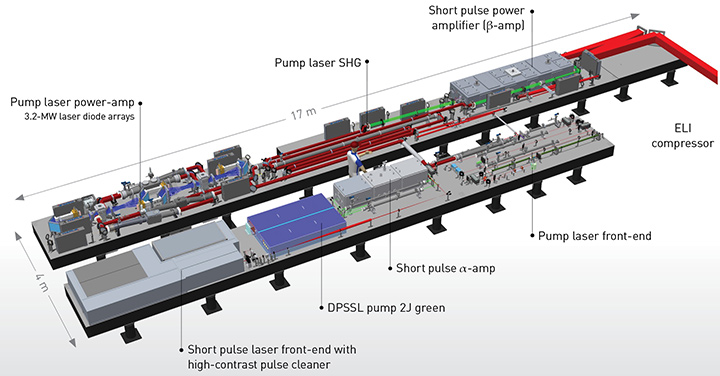 The HAPLS beamline: The architecture and engineering design of the HAPLS enables a compact form factor. [Courtesy of LLNL]
The HAPLS beamline: The architecture and engineering design of the HAPLS enables a compact form factor. [Courtesy of LLNL]
Inside the HAPLS
HAPLS is composed of two main subsystems: an advanced high-energy, diode-pumped solid-state laser system (the pump laser), and a broadband, CPA Ti:sapphire beamline (short-pulse laser), all managed by an integrated control system.
The pump laser beamline is designed to produce up to 200 J of 1053-nm light at a 10-Hz repetition rate. That energy is subsequently frequency converted and delivered to the high energy Ti:sapphire amplifier. LLNL and Lasertel Inc. jointly developed the High-power Intelligent Laser Diode System (HILADS), the highest-peak-power, brightest pulsed-diode light delivery system in the world, to energize the pump laser gain medium.
Equally critical to high-average-power operation is removing heat from the amplifier head. The design of both the HAPLS pump laser and main Ti:Sa amplifier enables efficient heat management both by minimizing the amount of deposited heat and by efficiently removing the heat that remains. HAPLS uses a multi-slab amplifier design cooled by room temperature, high-flow-speed helium gas. The turbulent gas flow extracts heat from the laser slab interfaces inside the laser head, minimizing thermally induced beam quality degradation.
The short-pulse beamline is a three-stage Ti:sapphire-based CPA system designed to produce 30-J pulses at 10 Hz, to be delivered with pulse duration shorter than 30 fs, yielding a peak power of greater than 1PW. The front end consists of a commercial short-pulse laser operating at 100 Hz. The beam is then amplified in the second stage, an eight-pass preamplifier pumped by a commercial diode-pumped solid-state laser. This Alpha amplifier produces pulses of greater than 0.5 J at a 10-Hz rate. Amplification to the full HAPLS output energy takes place in the Beta amplifier, a four-pass cavity configuration containing the helium-cooled amplifier head described above. Both LLNL-designed amplifiers are fully relay-imaged to preserve beam quality, to reduce the B-integral (optical nonlinearities that can distort the pulse), and to increase efficiency.
The laser architecture outlined above results in a system with an unusually compact footprint for a laser of these specifications. Including support electronics, the L3 HAPLS laser will consume only around 20 m by 5 m of floor space—a small fraction of the total space available in the ELI–Beamlines laser hall.
The L3 laser systems use an automated control system that manages human and machine safety at full repetition rate, while displaying and archiving all pertinent data for end-users of the output beam in the ELI–Beamlines experimental halls and for monitoring the health of the laser itself. Two operators can control the system; ELI–Beamlines staff received early training in the operation and maintenance of the system by participating in the commissioning of the laser system over the course of approximately one year.
The entire system was designed, built and integrated at LLNL, and commissioned to an intermediate performance level of 16 J at 3⅓ Hz, or 53 W (currently capable of delivering around 0.4 PW of peak power on the target). This intermediate performance level allowed the team to assess the capability of the HAPLS, when fully integrated within the ELI–Beamlines facility, to meet its design performance. After only three years of development from concept to product, the laser was shipped in mid-June 2017 to ELI–Beamlines, where it will be installed and further ramped to its full design performance of 30 J, 30 fs, 10 Hz and 300 W of average power.
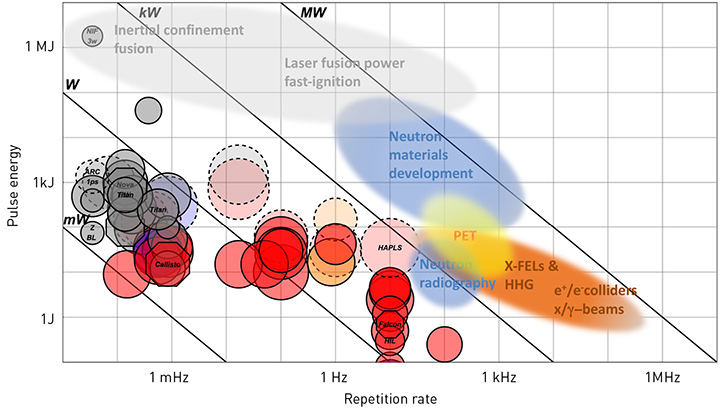 Breakthrough needed: Decommissioned, existing and planned PW-class high-intensity laser facilities all have average powers below the 1 kW limit. Most useful secondary-source applications, however, will require average-power levels of tens to hundreds of kW—a situation that demands a breakthrough in ultrafast laser technology. [Courtesy of LLNL]
Breakthrough needed: Decommissioned, existing and planned PW-class high-intensity laser facilities all have average powers below the 1 kW limit. Most useful secondary-source applications, however, will require average-power levels of tens to hundreds of kW—a situation that demands a breakthrough in ultrafast laser technology. [Courtesy of LLNL]
The Future of PW Lasers
When it reaches production operation, the HAPLS laser will be in a class of its own, enabling the development of several applications driving the ELI project. Yet some of the most promising applications are even more photon-hungry. Scientists using pulsed-laser facilities such as ELI–Beamlines will continue to optimize the production of the secondary sources and demonstrate new target designs and new potential applications capable of operating at multi-Hz repetition rates. Yet short-pulse high-peak-power, high-intensity laser technology needs to become more robust and efficient to access even the promising application spaces already identified.
Over the coming decade, lasers based on innovative concepts could well smash the current record average power for PW-class lasers, enabling a host of promising applications.
While roughly 1 PW of peak power is sufficient for these applications, repetition rate—and, thus, average laser power—can also be a key consideration. Repetition rates of tens of pulses per second are too slow, for example, to replace RF accelerators or to provide proton cancer therapy to a real tumor in a human subject. Depending on the application, repetition rates of 100 Hz to 10 kHz may be required—an increase of up to three orders of magnitude from the current HAPLS state-of-the-art. This pushes the average laser output power to the 100-kW regime; at those average-power levels, operating costs become very significant, and wall-plug efficiency becomes increasingly important.
At these much higher average-power levels, the indirect (laser-pumped laser) architecture used in Ti:sapphire PW lasers is no longer practical due to the inherently low efficiency. Direct CPA, in which a broadband gain medium is directly pumped with efficient laser diodes, is the next step towards multi-kW to 100-kW average-power ultrafast lasers. LLNL and several other institutions around the world are developing concepts for PW-class lasers capable of meeting these ambitious goals. Over the coming decade, lasers based on these innovative concepts could well smash the current record average power for PW-class lasers, enabling a host of promising applications and capabilities—and joining the many other types of lasers that have become ubiquitous and essential in modern society.
Prepared by LLNL under Contract DE-AC52-07NA27344.
Thomas M. Spinka and Constantin Haefner are with the Advanced Photon Technologies group at Lawrence Livermore National Laboratory, USA.
References and Resources
-
LLNL Sci. & Tech. Rev., Dec. 1996, URCL-52000-96-12, https://str.llnl.gov/str/pdfs/12_96.pdf
-
M.D. Perry et al. “Petawatt laser pulses,” Opt. Lett. 24, 160 (1999).
-
A. Bayramian et al. “The Mercury project: A high average power, gas-cooled laser for inertial fusion energy development,” Fus. Sci. Tech. 52, 383 (2007).
-
V. Coffey. “Ultrafast and ultrashort: Some recent advances in pulsed lasers,” Opt. Photon. News 25(5), 28 (May 2014).
-
C.M. Brenner et al. “Laser-driven X-ray and neutron source development for industrial applications of plasma accelerators,” Plasma Phys. Contr. Fus. 58, 014039 (2015).
-
E. Fulkerson et al. “Pulsed power system for the HAPLS Diode Pumped Laser System,” Pulsed Power Conference (2015).
-
J. Wenz et al. “Quantitative X-ray phase-contrast microtomography from a compact laser-driven betatron source,” Nat. Commun. 6, 7568 (2015).
-
C.L. Haefner et al. “High average power, diode pumped petawatt laser systems: A new generation of lasers enabling precision science and commercial applications,” Proc. SPIE 10241, 1024102 (2017).
-
K. Nakamura et al. “Diagnostics, control and performance parameters for the BELLA high repetition rate petawatt class laser,” IEEE J. Quantum Electron. 53, 1200121 (2017).
